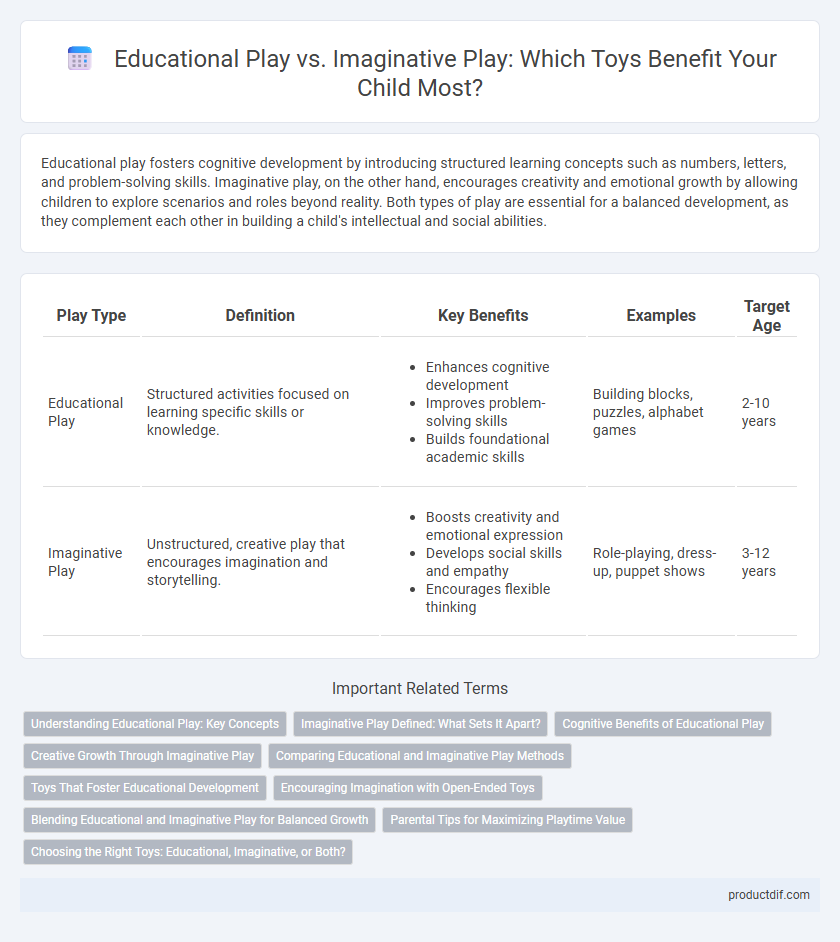Educational play fosters cognitive development by introducing structured learning concepts such as numbers, letters, and problem-solving skills. Imaginative play, on the other hand, encourages creativity and emotional growth by allowing children to explore scenarios and roles beyond reality. Both types of play are essential for a balanced development, as they complement each other in building a child's intellectual and social abilities.
Table of Comparison
| Play Type | Definition | Key Benefits | Examples | Target Age |
|---|---|---|---|---|
| Educational Play | Structured activities focused on learning specific skills or knowledge. |
|
Building blocks, puzzles, alphabet games | 2-10 years |
| Imaginative Play | Unstructured, creative play that encourages imagination and storytelling. |
|
Role-playing, dress-up, puppet shows | 3-12 years |
Understanding Educational Play: Key Concepts
Educational play involves structured activities designed to promote specific learning outcomes such as cognitive development, problem-solving skills, and knowledge acquisition. It emphasizes goal-oriented tasks using tools like puzzles, math games, and science kits to enhance critical thinking and concept mastery. This type of play integrates curriculum-aligned content, fostering both academic skills and real-world understanding in early childhood development.
Imaginative Play Defined: What Sets It Apart?
Imaginative play involves children creating scenarios, roles, and stories, allowing them to explore creativity and emotional expression beyond structured learning. Unlike educational play, which emphasizes cognitive skills and knowledge acquisition, imaginative play fosters problem-solving, social development, and symbolic thinking through open-ended activities. This form of play is crucial for developing abstract thinking and enhancing language skills by encouraging children to invent and narrate their own experiences.
Cognitive Benefits of Educational Play
Educational play enhances cognitive development by promoting problem-solving skills, logical thinking, and memory retention through structured activities. Toys like puzzles, building blocks, and interactive learning kits stimulate brain function and improve attention span, supporting academic performance. Consistent engagement in educational play fosters critical thinking and language acquisition, laying a strong foundation for lifelong learning.
Creative Growth Through Imaginative Play
Imaginative play fosters creative growth by encouraging children to invent stories, roles, and scenarios that enhance cognitive flexibility and problem-solving skills. Unlike educational play, which focuses on structured learning objectives, imaginative play allows for open-ended exploration and self-expression, crucial for developing creativity and emotional intelligence. Toys that inspire role-playing, storytelling, and scenario building significantly contribute to a child's innovative thinking and creative development.
Comparing Educational and Imaginative Play Methods
Educational play emphasizes structured activities designed to teach specific skills such as literacy, numeracy, and problem-solving through tools like puzzles and learning games. Imaginative play fosters creativity and social development by encouraging children to use role-playing, storytelling, and open-ended toys like dolls and building blocks. Both methods promote cognitive growth and emotional intelligence but differ in approach, with educational play targeting knowledge acquisition and imaginative play enhancing creativity and social skills.
Toys That Foster Educational Development
Toys that foster educational development, such as puzzles, building blocks, and STEM kits, promote cognitive skills like problem-solving, critical thinking, and spatial awareness. These educational toys support early literacy, math abilities, and scientific reasoning by engaging children in structured learning activities. Contrastingly, imaginative play toys like action figures and dress-up sets encourage creativity and social skills, but educational toys provide measurable developmental benefits aligned with academic growth.
Encouraging Imagination with Open-Ended Toys
Open-ended toys such as building blocks, art supplies, and dollhouses encourage imagination by allowing children to create their own narratives and scenarios without predefined rules. Educational play that incorporates these toys promotes cognitive development, problem-solving skills, and creativity more effectively than structured toys with fixed outcomes. Studies show that children engaged in open-ended play demonstrate enhanced language skills and flexible thinking, key components for lifelong learning.
Blending Educational and Imaginative Play for Balanced Growth
Blending educational play with imaginative play enhances children's cognitive and creative development by combining structured learning with open-ended exploration. Incorporating puzzles, building blocks, and role-playing toys encourages problem-solving skills while sparking creativity and social interaction. This balanced approach supports holistic growth, fostering critical thinking, communication, and emotional intelligence simultaneously.
Parental Tips for Maximizing Playtime Value
Parental guidance enhances both educational play, which develops cognitive skills like problem-solving, and imaginative play, fostering creativity and emotional growth. Offering a balanced mix of puzzles, building blocks, and role-playing toys encourages diverse learning experiences and sustained engagement. Setting regular, distraction-free play sessions promotes deeper focus and maximizes developmental benefits in young children.
Choosing the Right Toys: Educational, Imaginative, or Both?
Selecting toys that balance educational and imaginative elements fosters comprehensive child development by enhancing cognitive skills and creativity simultaneously. Educational toys like puzzles and STEM kits build critical thinking and problem-solving abilities, while imaginative toys such as dolls and building blocks encourage storytelling and role-playing. Opting for hybrid toys that integrate learning objectives with open-ended play maximizes developmental benefits, promoting both knowledge acquisition and creative expression.
Educational play vs imaginative play Infographic

 productdif.com
productdif.com